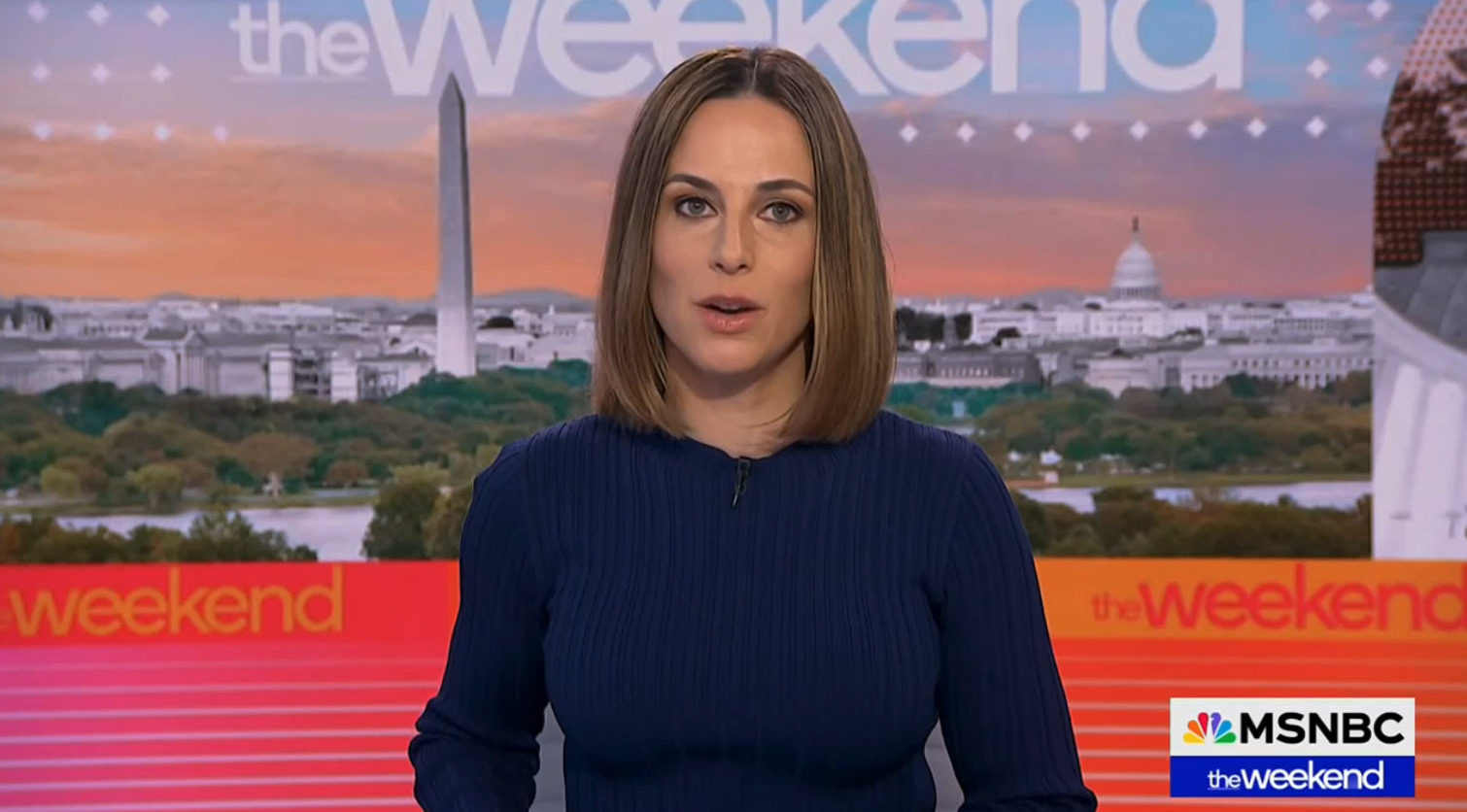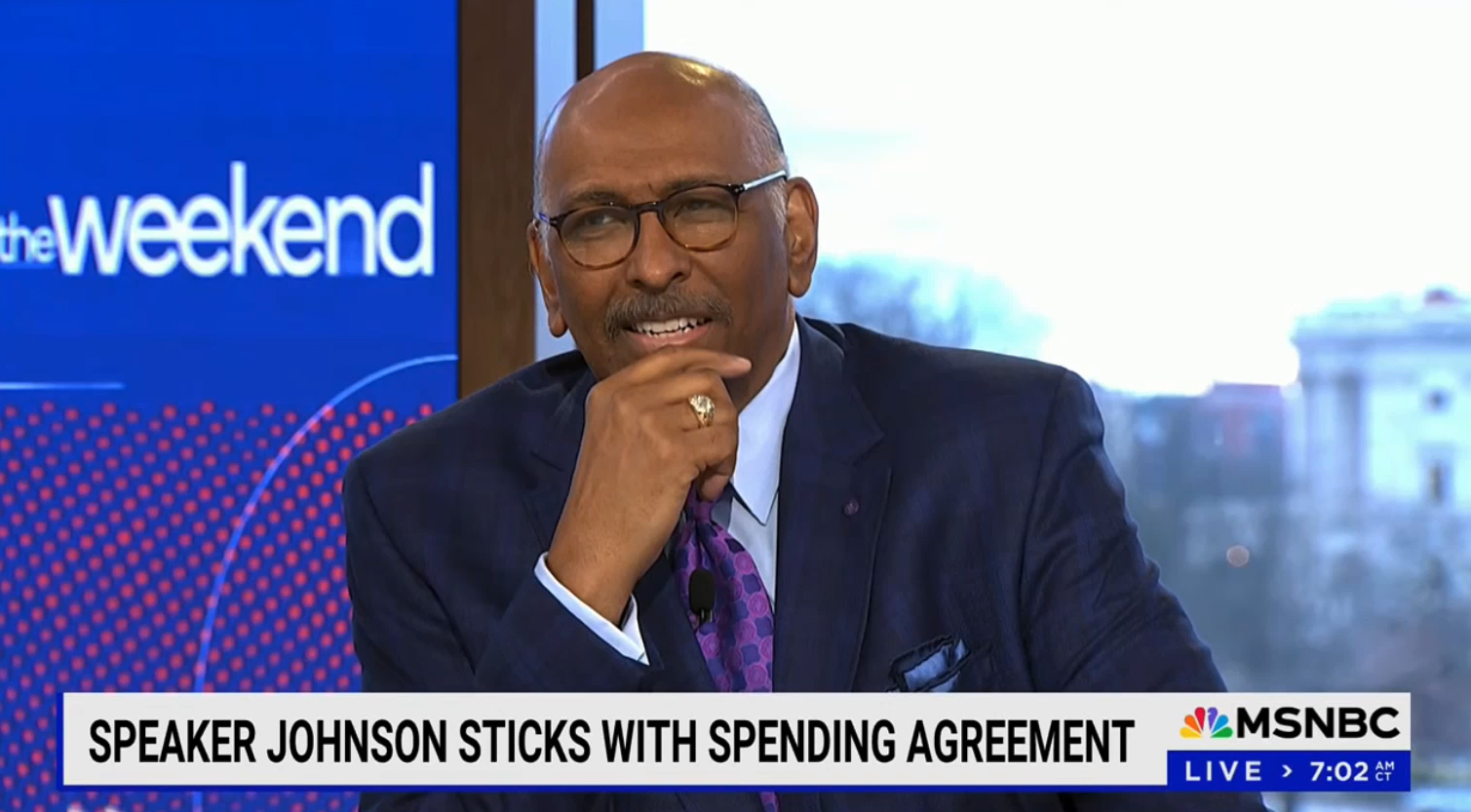MSNBC brings unique, colorful new look to ‘The Weekend’ schedule

Subscribe to NewscastStudio for the latest news, project case studies and product announcements in broadcast technology, creative design and engineering delivered to your inbox.
MSNBC debuted its new weekend panel show Jan. 13, 2024, using a bold and eclectic look that combines references to curves, halftones and a variety of textures while also giving each host some ways to stand out.
The show, announced earlier in January 2024, uses a panel format and is hosted by Alicia Menendez, Michael Steele and Symone Sanders-Townsend.
“The Weekend” originates from Studio N5 at the network’s Washington, D.C., bureau near the Capitol.
The show brought out the high circular table often used in this space for the three hosts and guests to sit around, which is placed slightly forward of the studio’s large video wall alcove. That background is used at the top of the show when Menendez, who sits camera center of this view directly in front of the center wall, introduces herself and the other hosts.
“The Weekend” uses circular elements as a major motif in the show’s design — including showcasing the trio of hosts in at the start of the open in three “arches” that could be seen as a nod to the NBC peacock’s feather shape.

The open takes viewers through a kaleidoscope of scenes, including a multicolor-banded animated wipe with the show’s logo repeated inside of each.
Hosts are then each showcased with their own unique sub-look, if you will, which is first hinted at in the triptych of photos at the very start of the open.
Menendez gets top billing against a red, orange and violet background with halftone dots and yellow text. Halftones are, by definition, a series of repeating dots and they often change in size to create the illusion of darker areas of an image, so it’s a natural choice for a textural pattern for the look.
Steele is next with a dark blue background accented with red lines in increasing or decreasing thicknesses — a look that’s probably the simplest of the three. The lines are similar to the color-changing backlit staggered horizontal elements found along the base of the video wall and part of the wall opposite the setup.
Sanders-Townsend is placed in front of a green background (which happens to be one of the signature colors of her previous show, “Symone”). Violet lines and a repeating colorful array of silhouettes are also used.
All told, there’s a core set of visuals blended in one or more of each of these looks — lines, circles, halftones, oversized typography, and color.

The view then shifts to an off-white background with black halftones, line accents and a series of black shapes that, through somewhat choppy animation, move around the screen and eventually serve as the base for the various letters in the show title.
For example, three different circular shapes form the three “e”s in “Weekend,” echoing their roughly circular shape, while three triangles form the “W.” Other elements include cursor-like rectangles and angled lines in both thin and thick varieties.
The lowercase “n” is formed with the curved arch accent and a series of halftone marks, which fill in the space under the letter’s curved leg in the logo. A circular bubble forms in the middle right of the screen and quickly reveals the host three-shot in the studio in front of the video walls.
In this view, the perpendicular video wall behind Steele’s position camera left draws much of its look on his part of the open. On the opposite side of the table, Sanders’ green is used.
Menedez’s color palette runs along the bottom of the center video wall behind her camera center position. As the center portion, the design also features a stylized D.C. skyline placed off-center with an irregular array of repeating circles used as a matte along the top.
All three backgrounds feature additional photography inspired by Washington; again, many of them are placed inside circular frames.
Steel’s blue background features a widely spaced series of marks that slowly get larger as the eye moves from the top to bottom of the graphic, similar to how the lines change thickness in his part of the open (incidentally, those lines find their way into the camera center background behind Menedez).
Sanders’ background, meanwhile, has slightly more imagery and features a tightly spaced circular pattern that winds up with lighter greet four-pointed sparkle shapes.

No camera blinds are used to capture “in the round” layout; instead cameras for Steele and Sanders-Townsend appear on either side of the studio at various times. They’re positioned so that Steele’s body blocks most of Sanders-Townsend’s camera from view and vice-versa.

Menedez’s one-shot largely features the D.C. cityscape and the bold bands running horizontally along the lower part of the graphic.

Steele is shot in front of Studio N5’s real windows overlooking the Capitol, with the LED column found here fed a blue image with the show logo, an array of red dots and a thin curved line that appears to be either taken from the show’s graphics or part of a peacock feather.

Sanders-Townsend’s one shot typically includes a video screen with internally lit frames built into the wall along one side of the studio and an edge-lit peacock element.
It’s worth noting how both the CR and CL positions both have a peacock-like element in the background — and how, in its simplest form, a peacock feather consists of a circular tip with straight but angled lines, much like many of the elements found in the show’s graphics.

When an in-studio guest is featured, he or she sits across from Menendez, though slightly off-axis. This person’s one shot is the blocky column in the corner where a three-panel array of screens meets the wall of windows. The background, in this case, is the wood-toned column and its blocky edge-lit horizontal accent segments (similar in profile to those found in the open to form the “k”).

The smaller on-set monitors throughout the studio typically feature different looping animations of the show logo against a constantly morphing wash of colors borrowed from those in the open and other spots. The loops typically don’t match, allowing a myriad of colors to be on-screen. In some cases, these arrays are also used to promote social media profiles or other MSNBC programming with a camera slowly zooming in on the panel with a corresponding graphic.
Subscribe to NewscastStudio for the latest news, project case studies and product announcements in broadcast technology, creative design and engineering delivered to your inbox.




tags
Alicia Menendez, Michael Steele, MSNBC, Studio N5, Symone Sanders-Townsend, The Weekend
categories
Branding, Broadcast Design, Broadcast Industry News, Cable News, Graphics, Heroes